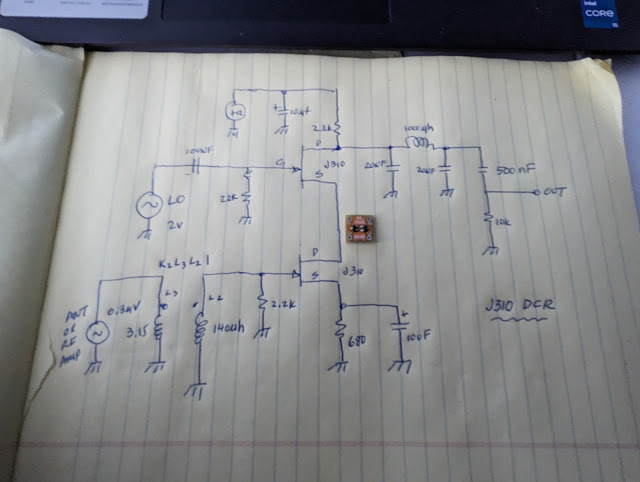Recently I was asked what is the Simplest Receiver? Hands down it is the Direct Conversion Receiver! Today's post is to talk about that receiver topology made all the simpler by the Wizard of Portland and a new small board he will be selling. I have a couple of advanced copies of the board and want to share some info with you about a DCR project using two J310's as a DGM.
You can find more info on the J310 DCR here.
Consider this as leaking-edge info on Todd's new product thus sign up for his newsletter to get the release date and the pricing info. Go to https://www.mostlydiyrf.com for the sign up.
Some observations about the unit -- it is small and K7TFC has made it easy to use. There are holes at the connection points so you can solder stiff wires in the holes and make these plug-in units for socketing. In the event the range of your security blanket is limited to a Manhattan pad then with the stiff wire that can be soldered to the pads.
In the most recent issue of the G-QRP Club SPRAT there was an article for a Matchbox Transmitter. If on Gate #2 we hang a 7030 Crystal with a trimmer cap (as a VXO) and likely a resistor you would not need a Si5351, and the matching Match Box Receiver has now arrived. A BFR106 as an RF amp would likewise be small. Round that out with a LM386 audio amp. Todd also sells the BFR106 boards. LEGO Blocks guys!
Thanks to Lew McCoy (SK) who 1st published a QST article about using a Gate on a DGM as an Oscillator port. See my February 7, 2024, Blog Post.
The L3, L2 windings are 3 Turns and 20 Turns. That is to match 50 Ohms looking into Gate #1. (2.2K). 50:2200 = 1 to 44.44. 20^2 = 400 and 3^2 = 9. 400/9 = 44.44. QED! The core is a FT-37-43. The Pi Filter on the output Drain of the top J310 is to pass only audio frequencies. Now the astute Blog Reader will quickly identify that this is not just a DCR but is indeed a Product Detector.
73's
Pete N6QW





.jpg)
.webp)
.jpg)


.jpg)